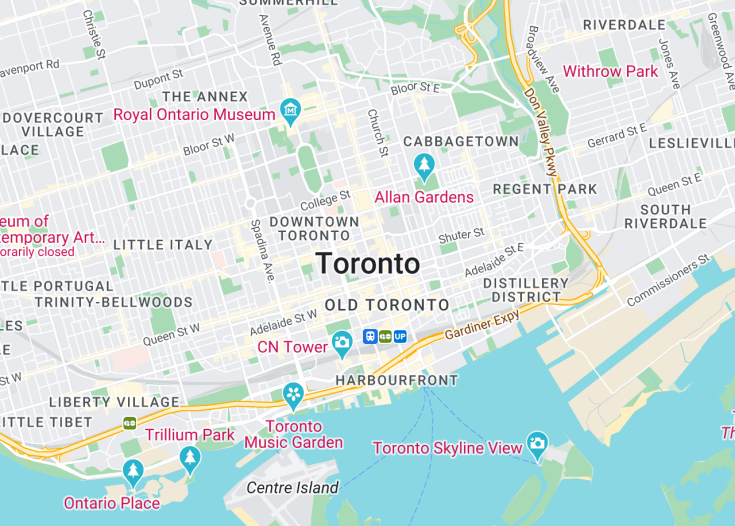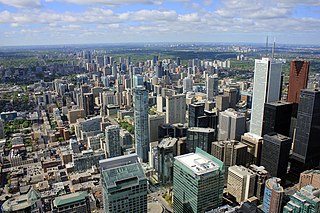Toronto, Canada’s largest city, is a bustling hub of culture, finance, and arts located along the shores of Lake Ontario. Renowned for its diverse population, Toronto offers a vibrant food scene, world-class museums, and a dynamic entertainment district. Whether exploring the iconic CN Tower, the historic Distillery District, or the sprawling green spaces like High Park, visitors are immersed in a blend of cultural and urban experiences. The city’s efficient public transit and welcoming atmosphere make it an ideal destination for travelers seeking a cosmopolitan adventure.
Prioritize visiting the Royal Ontario Museum and Art Gallery of Ontario to enjoy a rich tapestry of global and indigenous art, perfect for cultural enthusiasts.
Consider exploring Toronto’s diverse neighborhoods such as Chinatown, Little Italy, and Kensington Market to experience its multicultural vibrancy firsthand.
How to best experience Toronto?
Tickets, tours, and activities for Toronto are available at these providers:
Click on the logos below to easily compare prices.


Feeling lucky? Try the direct search:
GetYourGuide.com Viator.com Trip.com Expedia.com Tiqets.com Ctrip.com (中文)
Top things to do & see in Toronto
Select the following sights and activities to discover best tickets and tours available in Toronto.
Toronto: The Multicultural Hub of Canada
| Country | Canada |
| Time in Toronto | GMT-4 |
| Language spoken | English |
| Population | 2,731,571 (source: latest census data) |
| Currency | Canadian Dollar (CAD $) |
| Airports |
|
Known for its high skyscrapers and vibrant cultural life, Toronto is the largest city in Canada and the capital of Ontario. It’s a dynamic metropolis with a core of soaring skyscrapers, all dwarfed by the iconic, free-standing CN Tower. Toronto also encompasses a multicultural array of distinct ethnic neighborhoods, including Chinatown, Little India, and Little Italy, each offering a piece of global culture. The city is a prominent center for music, theater, motion picture production, and television production, and is recognized for being one of the most multicultural and cosmopolitan cities in the world.
Where is Toronto?
Situated on the northwest shore of Lake Ontario in Canada, Toronto serves as the heartland of the Greater Toronto Area.
Distances:
| Route | Distance by car | Time by car |
| Toronto to Montreal | 336 miles | 5 hours 30 min |
| Toronto to Ottawa | 279 miles | 4 hours 30 min |
| Toronto to Niagara Falls | 79 miles | 1 hour 30 min |
What is Toronto famous for?
Toronto is famous for its high-rise buildings, including the CN Tower, and its many green spaces. It’s also recognized for its rich diversity and vibrant arts scene, from music to theater and film.
History
Before 1600: Indigenous Lands
The area now known as Toronto was originally inhabited by Indigenous peoples for thousands of years, primarily the Huron-Wendat, the Seneca, and most recently the Mississaugas of the Credit River. The region was rich in resources, including vast forests and abundant water, supporting these communities with fishing, hunting, and agriculture.
1600-1793: European Exploration
European explorers began arriving in the early 17th century, with Étienne Brûlé being one of the first recorded Europeans to traverse the Toronto area. By the late 18th century, the British had established the Toronto Purchase in 1787, where they bought land from the Mississaugas of the New Credit, leading to the establishment of the ‘Town of York’ in 1793, named in honor of Prince Frederick, Duke of York and Albany.
1794-1867: Colonial Growth and Development
As the burgeoning community of York grew, it became the capital of Upper Canada in 1796. Struck by several American raids during the War of 1812, York was pivotal in several battles. Post-war expansion and immigration spurred rapid growth, and in 1834, York was incorporated as the city of Toronto, adapting an indigenous word “tkaronto” implying the “place where trees stand in the water.”
1867-1945: Industrial Expansion and Modernization
Admitted into the newly formed Confederation of Canada in 1867, Toronto swiftly expanded, benefiting from an influx of immigrants and the establishment of railway systems. This era saw significant industrialization and the rise of neighborhoods like Cabbagetown and The Annex, as well as improvements in public infrastructure, including water supply and roadways. The city also played an integral role during both World Wars as a major recruitment and supply center.
1945-present: Becoming a Global Metropolis
In the post-war period, Toronto transformed into a vibrant urban center, diversifying economically and culturally through waves of immigration from Europe, Asia, and other parts of the world. It became a mosaic of cultures, which is reflected in its eclectic neighborhoods and cuisine. Today, Toronto stands as Canada’s largest city and a prominent global metropolitan area known for its high livability, economic opportunities, and cultural significance.
Visit Toronto
What to See and Do in Toronto
Renowned for its rich tapestry of cultural offerings and vibrant urban life, Toronto offers myriad attractions and activities. Explore the iconic CN Tower, where you can dine in a revolving restaurant with sweeping city views. Dive into history at the Royal Ontario Museum or marvel at the innovative designs of the Art Gallery of Ontario.
- Take a stroll through the historic Distillery District for unique shops and eateries.
- Catch a Blue Jays game at Rogers Centre during baseball season.
- Visit the Toronto Islands for a peaceful escape from the urban bustle.
- Experience the bustling nightlife and entertainment of King Street West.
Signature Events in Toronto
Toronto’s calendar is packed with dynamic events that reflect its diverse cultural fabric. The Toronto International Film Festival (TIFF), held annually in September, draws global cinema enthusiasts and stars alike. Caribana, Toronto’s celebration of Caribbean culture, features a vibrant parade and music, occurring each summer in July or August. Winter enthusiasts will enjoy the Cavalcade of Lights, when Toronto’s Nathan Phillips Square becomes a spectacle of holiday lights and ice skating performances, starting in November.
Best Time to Visit Toronto
The ideal seasons to visit Toronto are late spring through early fall (May to September), when the weather is most amicable for exploring the outdoors. This period provides an opportunity to fully enjoy Toronto’s parks, waterfront, outdoor festivals, and patio dining culture.
Is Toronto Worth Visiting?
Toronto is undoubtedly a worthy destination for travelers seeking a blend of cultural richness, historical depth, and modern attractions. The city prides itself on its diverse communities, which translate into an array of international cuisines, vibrant marketplaces, and multicultural festivals. However, visitors should be prepared for the high cost of living and potential traffic congestion, common in major urban centers. Despite these challenges, Toronto’s friendly ambiance, coupled with its clean and safe environment, makes it a fulfilling destination for any travel enthusiast.


